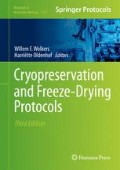Abstract
Cryopreservation is currently the method of choice when it comes to long-term preservation of viable biological samples. The process, and consequently the volume of the sample, however, is limited by the ability to achieve homogenous and efficient heat removal. When this cannot be properly managed, ice crystals will grow uncontrollably resulting in extensive damage to the cryopreserved cells or tissues. Directional freezing is a technique that can be used to precisely control heat dissipation and ice crystal growth and morphology even when freezing large volumes. The technique has been used over the years to cryopreserve spermatozoa, oocytes, embryos, tissue slices and whole organs from a wide variety of domestic and wild species. In this chapter a protocol for directional freezing of spermatozoa is described and its benefits and shortcomings are discussed.
Access this chapter
Tax calculation will be finalised at checkout
Purchases are for personal use only
References
Mazur P (2004) Principles of cryobiology. In: Fuller BJ, Lane N, Benson EE (eds) Life in the frozen state. CRC Press, Boca Raton, FL, pp 3–65
Watson PF (2000) The causes of reduced fertility with cryopreserved semen. Anim Reprod Sci 60–61:481–492
Saragusty J, Gacitua H, Rozenboim I, Arav A (2009) Do physical forces contribute to cryodamage? Biotechnol Bioeng 104:719–728
Saragusty J, Gacitua H, Rozenboim I, Arav A (2009) Protective effects of iodixanol during bovine sperm cryopreservation. Theriogenology 71:1425–1432
Arav A (2014) Cryopreservation of oocytes and embryos. Theriogenology 81:96–102
Arav A, Saragusty J (2013) Directional freezing of spermatozoa and embryos. Reprod Fertil Dev 26:83–90
Saragusty J, Gacitua H, Zeron Y, Rozenboim I, Arav A (2009) Double freezing of bovine semen. Anim Reprod Sci 115:10–17
Saragusty J, Hildebrandt TB, Behr B, Knieriem A, Kruse J, Hermes R (2009) Successful cryopreservation of Asian elephant (Elephas maximus) spermatozoa. Anim Reprod Sci 115:255–266
Hermes R, Saragusty J, Göritz F, Bartels P, Potier R, Baker B, Streich WJ, Hildebrandt TB (2013) Freezing African elephant semen as a new population management tool. PLoS One 8:e57616
Revel A, Elami A, Bor A, Yavin S, Natan Y, Arav A (2001) Intact sheep ovary cryopreservation and transplantation. Fertil Steril 76:S42–S43 (abstract)
Maffei S, Pennarossa G, Brevini TAL, Arav A, Gandolfi F (2013) Beneficial effect of directional freezing on in vitro viability of cryopreserved sheep whole ovaries and ovarian cortical slices. Hum Reprod 29:114–124
Gavish Z, Ben-Haim M, Arav A (2008) Cryopreservation of whole murine and porcine livers. Rejuvenation Res 11:765–772
Elami A, Gavish Z, Korach A, Houminer E, Schneider A, Schwalb H, Arav A (2008) Successful restoration of function of frozen and thawed isolated rat hearts. J Thorac Cardiovasc Surg 135:666–672.e661
Arav A, Zeron Y, Shturman H, Gacitua H (2002) Successful pregnancies in cows following double freezing of a large volume of semen. Reprod Nutr Dev 42:583–586
Rubinsky B, Arav A, DeVries AL (1991) Cryopreservation of oocytes using directional cooling and antifreeze glycoproteins. CryoLetters 12:93–106
Arav A (1992) Vitrification of oocytes and embryos. In: Gandolfi F, Lauria A (eds) New trends in embryo transfer. Portland Press, Cambridge, pp 255–264
Arav A, Rubinsky B, Fletcher G, Seren E (1993) Cryogenic protection of oocytes with antifreeze proteins. Mol Reprod Dev 36:488–493
Revell SG, Pettit MT, Ford TC (1997) Use of centrifugation over iodixanol to reduce damage when processing stallion sperm for freezing. J Reprod Fertil 19:38 (abstract)
Kim S, Agca C, Agca Y (2013) Effects of iodixanol during rat epididymal sperm cryopreservation. Cryobiology 67:432 (abstract)
Acknowledgement
The author is grateful to Dr. Amir Arav for useful suggestions on the manuscript, and to Drs. Roland Fray and Gabriela Galateanu for help with the figures.
Author information
Authors and Affiliations
Corresponding author
Editor information
Editors and Affiliations
Rights and permissions
Copyright information
© 2015 Springer Science+Business Media New York
About this protocol
Cite this protocol
Saragusty, J. (2015). Directional Freezing for Large Volume Cryopreservation. In: Wolkers, W., Oldenhof, H. (eds) Cryopreservation and Freeze-Drying Protocols. Methods in Molecular Biology, vol 1257. Springer, New York, NY. https://doi.org/10.1007/978-1-4939-2193-5_19
Download citation
DOI: https://doi.org/10.1007/978-1-4939-2193-5_19
Published:
Publisher Name: Springer, New York, NY
Print ISBN: 978-1-4939-2192-8
Online ISBN: 978-1-4939-2193-5
eBook Packages: Springer Protocols

